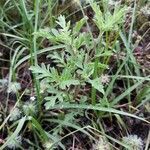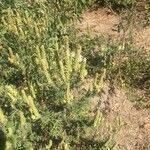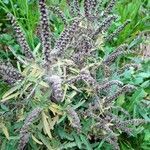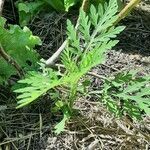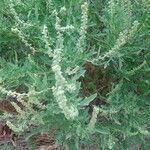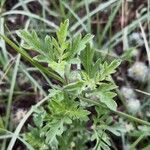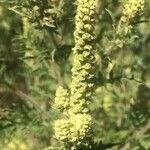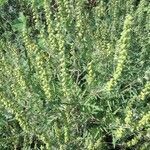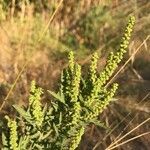Perennial herb, up to 1 m high. Stems simple, arising from underground runners. Leaves mostly opposite; blade ovate in outline, bipinnatisect, ultimate leaf segments narrowly oblong, on average < 2 mm wide, lobe apices acute to acuminate, lobe margins entire or minutely dentate, pubescent, light green, somewhat aromatic; petiole ± 10 mm long. Heads unisexual; male heads small, drooping, in slender, terminal racemes up to 120 mm long, arranged in panicles, involucral bracts connate, cup-shaped, containing several, functionally male florets; female heads solitary or 2 or 3 together in leaf axils below male heads, involucral bracts connate, turbinate, enveloping cypsela, containing single female floret, corolla absent. Flowers: disc florets only, whitish; Apr. Fruit with cypsela ovoid, enveloped in turbinate, involucral bracts, with 4-6 spines on shoulders. Pappus absent.
Perennials, 10–60(–100+) cm. Stems erect. Leaves proximally opposite, distally alternate; petioles 0–25 mm (often ± winged); blades deltate to lanceolate, 20–60(–140) × 8–35(–50+) mm, pinnately toothed to 1-pinnately lobed, bases cuneate to truncate, ultimate margins entire or toothed, abaxial and adaxial faces hirsutulous to strigose and gland-dotted. Pistillate heads clustered, proximal to staminates; florets 1. Staminate heads: peduncles 0.5–2 mm; involucres obliquely cup-shaped, 2–4(–5) mm diam., hirsutulous; florets 5–15(–30+). Burs: bodies ± obpyramidal to globose, 2–3 mm, hirsutulous, spines or tubercles 0 or 1–6, mostly distal, stoutly conic to acerose, (0.1–)0.5–1 mm, tips straight. 2n = 18, 27, 36, 45, 54, 63, 72, 100–104, 108, 144.
Erect, stout, perennial herb to 2 m high, often forming extensive colonies from its deep stoloniferous root system. Leaves opposite to alternate, 3–12 cm long, 1.5–4 cm wide, pinnately divided; segments lanceolate, sometimes toothed, scabrous to hirsute, often grey-green. Male capitula c. 2 mm diam., of 8–10 (–20) florets; involucral bracts fused 90–100% of their length; corollas glabrous. Female capitula in clusters of 1–6 (usually solitary), each with 1 floret, sessile in upper leaf axils. Conceptacles depressed-globular, c. 2 mm long, with a single row of 0–5 ±straight conical spines or teeth, with a terminal beak and a deltoid 3-winged peduncle, rugose, but lacking raised reticulate veins on surface, pilose, glandular.
Perennial herb, up to 1 m high; stems simple. Leaves opposite, petiolate, bipinnatisect, narrowly oblong, acute or acuminate, margins entire. Capitula unisexual. Male capitula in terminal racemes, paniculately arranged; involucre cup-shaped; bracts connate. Corolla tubular, campanulate above, 5-lobed. Anthers ± free, with incurved, linear apical appendage, base entire. Style undivided, truncate, penicillate. Ovary abortive. Female capitula sessile, solitary or clustered in upper leaf axils below males, 1-flowered; involucre enveloping cypsela and becoming indurated, turbinate, with 4-6 spines on shoulder below neck through which long, linear, papillose style branches exserted. Flowering time Apr. Cypselae ovoid, smooth.
Herbaceous perennial, stems simple, up to c. 1 m tall, arising from underground runners and so establishing large colonies. Leaves mostly opposite, bipinnatisect, the ultimate segments narrowly oblong, on average less than 2 mm broad, acute or acuminate, pubescent, light green, somewhat aromatic. Male heads small, drooping, in slender terminal racemes up to c. 12 cm long, paniculately arranged, female heads solitary or 2-3 together in the leaf axils below them.
Perennial herb, up to 1 m high, with simple stems arising from underground runners. Ultimate leaf segments on average narrower than 2 mm. Female heads solitary or 2 or 3 together in leaf axils below male heads. Flowers whitish.
